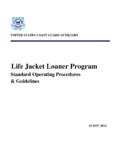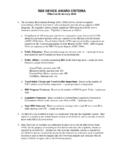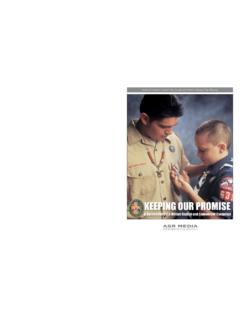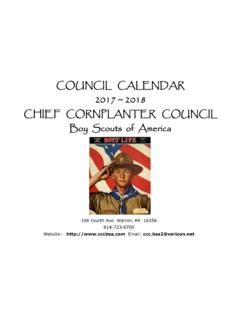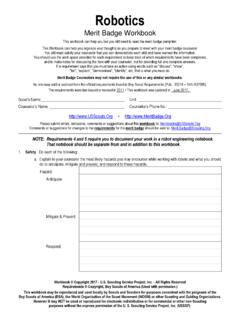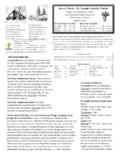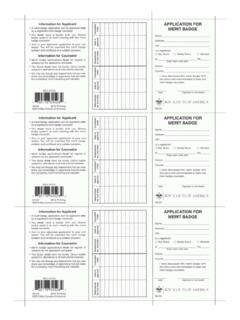Transcription of Guide to Sea Scout - Sea Cadet Shoreside and …
1 Guide to Providing Shoreside and underway training opportunities to Sea Cadets & Sea ScoutsThe purpose of this document is to provide guidance for providing Shoreside and underway training opportunities to Sea Cadets & Sea Scouts in accordance with the Memorandum of Understanding (MOU) between the Coast Guard Auxiliary ( Auxiliary ) and the Naval Sea Cadet Corps (NSCC)1, and the Memorandum of Agreement (MOA) between the Auxiliary and the Boy Scouts of America (BSA).2 The scope of training covered by this document includes standard Auxiliary boat crew and coxswain qualification tasks. It is recommended that Auxiliary boat crews be selected for their ability to mentor boat crew and coxswain trainees, as well as having prior experience working with youth or younger trainees through the Coast Guard Auxiliary or other youth-serving organizations. All participating crew members (including coxswains) should complete the following orientation prior to providing training to Sea Cadets and Sea Scouts aboard Auxiliary facilities under orders: Carefully read the NSCC MOU (if working with Sea Cadets) or BSA MOA (if working with Sea Scouts).
2 Complete the Venturing Leader Youth Protection training available online from the Boy Scouts of training will orient Auxiliarists to the NSCC MOU and/or BSA MOA, as well as orienting them to appropriate interactions with youth members of either process for bringing Sea Scouts and Sea Cadets on board OPFACS under orders is the same as bringing any guest on board, and is covered in the Operational Policy Manual, COMDTINST , Chapter 4, paragraph Sea Scouts and Sea Cadets should be provided with life jackets with appropriate impact ratings, and equipped with the same PPE as with Sea Cadets or Sea Scouts on board should not be tasked with SAR duties. In the unlikely event that an OPFAC with Sea Scouts or Sea Cadets aboard must respond to an incident, the youth must not be involved in the 2 3 Ground facilities used for Sea Scout or Sea Cadet training must be operated under orders with at least the minimum crew on board.
3 Number of Sea Cadets or Sea Scouts aboard must not exceed the number of crew. For example, if there are two Auxiliarist crew aboard, there should be no more than 2 Sea Cadets or Sea Scouts no time is it permissible for one Auxiliarist to be alone with one Coxswain has total discretion at all times to determine whether Sea Scouts or Sea Cadets are participating appropriately in a training opportunity. If the Coxswain determines that any youth s behavior is inconsistent with carrying out the mission, the Coxswain is encouraged to return the youth to the dock or abort the mission as underway training to Sea Cadets and Sea Scouts will be determined by the local Coast Guard Auxiliary district ( , District Commodore and Director of Auxiliary).Recommended training ActivitiesFollowing is a list of Auxiliary boat crew tasks/activities that can be provided by certified Auxiliarist Boat Crew for training Sea Scouts and Sea Cadets. Where applicable, the related Sea Scout Advancement4 item is identified.
4 When planning these training activities, the member should identify the specific training items to be covered and have sufficient quantities of Qualification Checklists and Advancement Scorecards to provide recordkeeping for the youth members involved. Youth with similar experience should be grouped together, and each session should build on the prior session. Shore Side TrainingBCM-02-01-AUXCrew First Aid Responsibility Sea Scout Advancement reference5: Able and Heat Related Factors Sea Scout Advancement reference: Able the Symptoms and Treatment for Shock 4 The Sea Scout Advancement program involves four advancement levels modeled after the merchant marine and sea services: Apprentice, Ordinary, Able and Quartermaster. Specific requirements are available online at: . Sea Scout advancement requirements and Boat Crew tasks/activities are not always worded the same, so the member will need to review and compare them to ensure that the specific requirements are satisfied before signed them off as completed.
5 All Sea Scout Advancement activities should be coordinated with the Sea Scout Adult Leader to ensure continuing within the Sea Scout unit advancement Sea Scout Advancement reference: Able Direct Pressure, Pressure Points, and Tourniquet Method to Control Bleeding Sea Scout Advancement reference: Able the Signs and Treatment for Burns Sea Scout Advancement reference: Able the Symptoms and Treatment for Hypothermia Sea Scout Advancement reference: Able Identify Boat Crew Survival Equipment Sea Scout Advancement reference: Apprentice Use the Emergency Signal Mirror Sea Scout Advancement reference: Apprentice BCM-02-11-AUX Describe the Use of Hand Held Distress Flares Sea Scout Advancement reference: Apprentice BCM-02-12-AUX Describe The Use Of Aerial Flares. Sea Scout Advancement reference: Apprentice Operate the Personal Marker Light (PML) or Strobe Light Sea Scout Advancement reference: Apprentice State Survival Procedures in Event the Boat Capsizes or Swamps BCM-03-01-AUX Identify the Different Parts of a Line and the Hitches Used In Line Handling Sea Scout Advancement reference: Ordinary Tie Various Knots, Hitches and Bends Sea Scout Advancement reference: Apprentice 6, Ordinary Secure Lines to Cleats, Bitts and Posts Sea Scout Advancement reference: Apprentice 6, Ordinary Identify Common Navigation Lights Displayed By Ships and Boats Sea Scout Advancement reference: Ordinary Identify Common Sound Signals Used By Ships and Boats Sea Scout Advancement reference: Ordinary Identify and Describe Accepted Maritime Distress Signals BCM-06-01-AUX Identify the Basic Parts, Symbols and Abbreviations Found On a Nautical Chart Sea Scout Advancement reference.
6 Able , the Different Classes of Fires Sea Scout Advancement reference: Able a CO2 Fire Extinguisher (Simulate) Sea Scout Advancement reference: Able a Dry Chemical Fire Extinguisher (Simulate) Sea Scout Advancement reference: Able Describe The Indicators Of Approaching Heavy Weather Sea Scout Advancement reference: Quartermaster , Quartermaster 11 COX-02-02-AUX Recognize Warning Signs Of An Unstable Vessel Sea Scout Advancement reference: Quartermaster State The Procedures To Follow If Engine Will Not Start Sea Scout Advancement reference: Able , Quartermaster State The Procedures To Follow For Loss Of Electrical Power Sea Scout Advancement reference: Able , Quartermaster State The Procedures To Follow For High Engine Temperature Sea Scout Advancement reference: Able , Quartermaster State Procedures To Follow For Low/No Engine Oil Pressure Sea Scout Advancement reference: Able , Quartermaster State The Procedures To Follow For Defective Charging System Sea Scout Advancement reference: Able , Quartermaster State The Procedures To Follow For Shaft Vibration Sea Scout Advancement reference: Able , Quartermaster State The Procedures To Follow For A Steering Casualty COX-03-01-AUX State The Forces That Affect Boat Handling Sea Scout Advancement reference: Able State The Basic Principles Of Boat Handling Sea Scout Advancement reference: Able State The Basic Concepts Related To Search Planning COX-06-05-AUX Plot A Single Unit Expanding Square Search Pattern (SS) COX-06-06-AUX Plot A Single Unit Sector Search Pattern (VS) Sea Scout Advancement reference: COX-06-07-AUX Plot A Single Unit Parallel Search Pattern (PS) Sea Scout Advancement reference.
7 COX-06-08-AUX Plot A Single Unit Trackline Return Search Pattern (TSR) COX-05-01-AUX Identify Navigational Publications Sea Scout Advancement reference: Able 9 COX-07-04-AUX State The Action To Take If Your Boat Was Aground underway TrainingBCM-03-04-AUX Assist the Coxswain with a Pre- underway Check-Off Aboard an Auxiliary Facility Sea Scout Advancement reference: Ordinary 5, Able 5 BCM-04-01-AUX Assist In Anchoring the Boat Sea Scout Advancement reference: Ordinary 8 BCM-04-02-AUX Assist in Weighing the Boat s Anchor Sea Scout Advancement reference: Ordinary 8 BCM-04-06-AUX Stand a Lookout Watch Sea Scout Advancement reference: Ordinary 11 BCM-04-08-AUX Cast Off and Stow Lines and Fenders Sea Scout Advancement reference: Able Prepare For, Moor and Secure the Boat to a Dock Sea Scout Advancement reference: Able , Quartermaster , Operate a VHF-FM Radiotelephone Sea Scout Advancement reference: Apprentice , Ordinary Use the VHF-FM Radiotelephone to Give a Position or Operations Normal Report Sea Scout Advancement reference: Ordinary Identify Common Aids to Navigation Used In Small Boat Piloting Sea Scout Advancement reference: Able Local Landmarks Used in Piloting on a Nautical Chart Sea Scout Advancement reference: Able a Position Using Latitude and Longitude Sea Scout Advancement reference: Ordinary a Magnetic Course on a Nautical Chart Sea Scout Advancement reference: Ordinary , Able Distance on a Nautical Chart Sea Scout Advancement reference: Ordinary , Able Time, Speed, and Distance Sea Scout Advancement reference: Ordinary , Able Determine the Depth of Water Using a Fathometer and/or a Sounding Pole BCM-07-01-AUX Participate In a Man Overboard Evolution as a Pointer Sea Scout Advancement reference.
8 Ordinary , Quartermaster Participate in a Man Overboard Evolution as a Recovery/Pick up Man Second Auxiliary Facility Sea Scout Advancement reference: Ordinary , Quartermaster Locate And Operate the Boat s Dewatering Equipment COX-03-04-AUXC omplete a Pre- underway Check-Off for the Facility Sea Scout Advancement reference: Able , , Quartermaster Maneuver A Boat In A Narrow Channel Or In A River COX-03-10-AUXA nchor the Boat Sea Scout Advancement reference: Ordinary the Boat s Anchor Sea Scout Advancement reference: Ordinary Commonly Used Sound Signals Sea Scout Advancement reference: Ordinary The Proper Navigation Lights For Common Operational Boat Evolutions Sea Scout Advancement reference: Ordinary , Able Obtain A Visual Fix Sea Scout Advancement reference: Able Determine A Compass Course From True Course Sea Scout Advancement reference: Ordinary Sketch A Chart Of The Local Operating Area COX-05-05-AUX Pilot A Boat Using Dead Reckoning Techniques Sea Scout Advancement reference: Ordinary , Able Pilot A Boat Using Seaman s Eye Sea Scout Advancement reference: Able Determine The Position Of A Boat Using Radar Ranges And Bearing Sea Scout Advancement reference: Able Determine The Position Of A Boat Using GPS/DGPS (If Equipped) Sea Scout Advancement reference: Able Determine Course To Steer And Speed Over Ground (SOG) Allowing For Set And Drift Sea Scout Advancement reference: Ordinary River Sailing, (Locks, Dams And Flood Warnings) And Pass Through A Lock COX-06-09-AUX Execute A Search Pattern COX-07-01-AUX Determine The Approach To An Object And Station Keep COX-07-02-AUXR ecover a Person from the Water Using the Direct Pick Up Method Sea Scout Advancement reference.
9 Ordinary , Quartermaster a Night Navigation and Piloting Exercise Sea Scout Advancement reference: Quartermaster.

